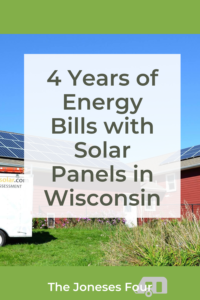Investing in solar panels is a big, overwhelming undertaking. Solar panels are expensive and, if you live in the Midwest, savings probably seem bleak. We live in Wisconsin and have had solar panels for almost four years now. Here are 4+ years of our energy bills. (And some other relevant data.) 🙂
Before we begin, please note the other relevant posts you’ll find on our blog:
- Should You Invest in Solar? 4 Reasons to Wait
- All Energy Solar: An Honest Residential Review
- 4 Money Saving Reasons to Invest in Solar Now

This post contains affiliate and referral links.
Timeline and relevant facts
- We purchased our home in June 2019. Our previous home was approximately 1,700 ft.²; our current home is approximately 2,700 sq. ft.
- We had a wood stove installed in December 2019 and solar panels were installed in January 2020. Our system was fully functional by mid-February (although it took the energy company a few months to catch up).
- We replaced our furnace in March 2021 (although any improvements in efficiency aren’t notable).
- At install, three trees notably blocked production. Since installation, two have been cut down (winter 2022 and summer 2022).
- We purchased a new, smaller, more efficient refrigerator in late 2021, but maintained our former model for holiday overflow and beverage storage. We are currently running two refrigerators. (We may need to revisit this after this analysis, though.)
Our solar panel system
Our solar system consists of 24 panels facing east/west with a 9,240 W DC inverter. Due to availability, the SolarEdge inverter was changed to an Enphase microinverter. This was a superior product that works on a panel-by-panel basis, as opposed to the whole system. (ie. storm damage affects just the damaged panels v. shutting down the whole system.) All Energy Solar made this shift at no cost to us.
(This was one of the many reasons they were so fantastic to work with! Read our review of their service.)
Does solar energy production carry over from month to month?
This may vary from state to state, but in Wisconsin, any excess solar production carries from month to month through the calendar year. January first is a fresh start for your solar production.
How your energy company handles any excess energy production at yearend will vary from state to state. In Wisconsin, if you have any excess at the end of the year, the company will issue you a check. (In our experience, this has not been the case.) Also in Wisconsin, our rate of reimbursement is lower than other states. My in-laws in Minnesota would receive a rate 3x the size, if they produced excess.
Production related insight: The month of March is a key time. Per our consultant, March is a major determinant in how well your production will carry through to the end of the year, and we have found this to be true.
(My next post will display our annual energy production on a month by month basis. Subscribe to be one of the first to read it!)
Energy bills with solar panels
Here’s the part you’ve all been waiting for. Again, we moved into our current home in June 2019 and installed solar in January 2020. At this point, we also had installed a wood stove, which provides much of our daytime heat. Nonetheless, we find that our friends and family are paying similar or higher energy costs for smaller properties.
| 2019 | 2020 | 2021 | 2022 | 2023 | |
| January | 177 | 212 | 158 | 225 | 222 |
| February | 197 | 219 | 218 | 279 | 296 |
| March | 187 | 188 | 247 | 243 | 202 |
| April | 190 | 164 | 109 | 153 | 137 |
| May | 171 | 136 | 83 | 123 | 70 |
| June | 183 | 103 | 54 | 51 | 39 |
| July | 284 | -149 | 36 | 34 | 31 |
| August | 235 | -205 | 33 | 37 | 31 |
| September | 195 | -172 | 33 | 32 | 31 |
| October | 150 | -138 | 46 | 32 | 31 |
| November | 149 | -97 | 74 | 47 | 35 |
| December | 216 | 35 | 142 | 113 | 50 |
| Total | $2,334 | $1,057 | $1,233 | $1,371 | $1,175 |
| Average monthly bill | 195 | 88 | 103 | 114 | 98 |
| Avg. natural gas price (Wisconsin) | $4.83 | $4.26 | $7.55 | $8.88 | 7.15* |
Natural gas price data: https://www.eia.gov/dnav/ng/hist/n3035wi3m.htm
The difference with solar panels
As you can see, our energy bills for the first half of the year have (in line with natural gas costs) kept our bills comparable to the time when we lived in a smaller house. The savings is predominantly recognized in the latter half of the year.
The table below displays the difference in energy costs for our household between April and December from 2019 to 2021, 2022, and 2023. Our energy bills in summer average about $40/mo. We are very much controlled climate people and always have our air conditioning running.
| Difference in Energy Bills from April – December | |||
| 2019 v. 2021 | 2019 v. 2022 | 2019 v. 2023 | |
| April | 81 | 37 | 53 |
| May | 88 | 48 | 101 |
| June | 129 | 132 | 144 |
| July | 248 | 250 | 253 |
| August | 201 | 198 | 204 |
| September | 162 | 163 | 164 |
| October | 103 | 118 | 119 |
| November | 75 | 102 | 114 |
| December | 74 | 103 | 166 |
| Annual savings | $1,162 | $1,150 | $1,317 |
If you want to get particular about our savings, you could subtract another $200 from the totals above to factor in our annual wood costs, however, we would have this with or without the solar panels. Nonetheless, the savings is notable and will only continue to compound throughout the years, mitigating energy price hikes and lessening our financial burden through the pricy DIY summers and holiday seasons.

Did I mention how nice those first few years of tax refunds were with the 30% tax incentive? They were FANTASTIC!
And from what I understand, this has been extended at 30% until 2032. (Cha-ching!)
Want to learn more? Check out some of our other posts about our solar journey or reach out to All Energy Solar for free consultation. They operate in Illinois, Iowa, Massachusetts, Minnesota, New Hampshire, and Wisconsin. They’re well-established and knowledgeable.
Well-established is so important! A friend of our opted for a start up solar company and they went out of business before they finished. (YIKES!) Don’t put yourself in that position.
We hope you found seeing our energy bills with solar panels in Wisconsin helpful in making your decision. While the savings aren’t immediate, if you plan to stay where you are, they will pay for themselves over time.
What other questions do you have about going solar in the midwest? Tell us in the comments below!
– Melissa, The Joneses Four




